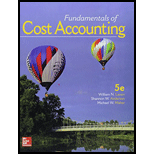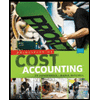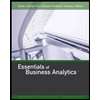
a.
Identify the unit cost which would be asked from the North Division to pay by the manager of the South Division.
a.
Explanation of Solution
The manager of the South Division is charging the cost on per unit basis including the fixed cost per unit. The differential costs are not taken into account while computing the cost per unit.
The options of charging the cost to North Division are as follows:
Option A: The price can be charged on the basis of the full per unit cost of 2,400 units.
Option B: The use of only differential costs for determining the price.
Option C: The use of differential costs and per unit fixed cost for calculating the price.
| Particulars | Costs | Unit cost Options | ||
| A | B | C | ||
| Direct materials | $ 200 (1) | $ 200 | $ 200 | $ 200 |
| Direct Labor | $ 96 (2) | $ 96 | $ 96 | $ 96 |
| Other variable costs | $ 64 (3) | $ 64 | $ 64 | $ 64 |
| Fixed costs | $ 2,016,000 | $ 840 (4) | $ - | $ 672 (5) |
| Per cost unit | $ 1,200 | $ 360 | $ 1,032 | |
| Cost plus 15% | $ 1,380 | $ 414 | $ 1,187 | |
| Total price (600 units) | $ 828,000 | $ 248,400 | $ 712,080 | |
The unit cost which would be asked from the North Division to pay by the manager of the South Division is as stated in Option A. The cost does not include the differential cost.
Thus, the unit cost which would be asked from the North Division to pay by the manager of the South Division is $1,200 per unit.
Working note 1:
Compute the Direct materials cost per unit:
Working note 2:
Compute the Direct labor cost per unit:
Working note 3:
Compute the other variable cost per unit:
Working note 4:
Compute the fixed cost per unit in option A:
Working note 5:
Compute the fixed cost per unit in option C:
b.
Identify the unit cost which would be argued from the North Division to be paid by the manager of the North Division.
b.
Explanation of Solution
The unit cost which would be argued from the North Division to be paid by the manager of the North Division is as stated in Option C. The cost includes the differential cost as well as unit fixed costs.
Thus, the unit cost which would be argued from the North Division to be paid by the manager of the North Division is $1,032 per unit.
c.
Explain the unit cost which should be recommended for a sale of units from the South Division to the North Division.
c.
Explanation of Solution
The unit cost which should be recommended for a sale of units from the South Division to the North Division is as stated in Option B. The cost includes the differential cost.
Thus, the unit cost which should be recommended for a sale of units from the South Division to the North Division is $300 per unit.
Want to see more full solutions like this?
Chapter 1 Solutions
GEN COMBO FUNDAMENTALS OF COST ACCOUNTING; CONNECT 1S ACCESS CARD
- Please explain the solution to this general accounting problem with accurate principles.arrow_forwardCan you solve this financial accounting problem with appropriate steps and explanations?arrow_forwardPlease provide the answer to this financial accounting question using the right approach.arrow_forward
- On January 1, 2024, Sunfish Co. issued a $22 million, 8%, 6-year convertible bond with annual coupon payments. Each $1,000 bond was convertible into 35 shares of Sunfish's common shares. Shark Investments purchased the entire bond issue for $22.7 million on January 1, 2024. Shark estimated that without the conversion feature, the bonds would have sold for $21,013,098 (to yield 9%). On January 1, 2025, Shark converted bonds with a par value of $8.8 million. At the time of conversion, the shares were selling at $30 each. Required Prepare the journal entry to record the issuance of convertible bonds. Prepare the journal entry to record the conversion according to IFRS (book value method). Prepare the journal entry to record the conversion according ASPE (market value method).arrow_forwardRoseBud Motel Ltd. (RM) had 100,000 ordinary shares outstanding during all of 2025, all owned by the owner Johnny Rose. In 2023, RM issued $500,000, 3% non-cumulative preferred shares. Each $100 preferred share is convertible into one ordinary share. RM also had 6,000, $100 cumulative preferred shares outstanding that are each entitled to an annual dividend of $1.60. Each preferred share is convertible into two ordinary shares. RM’s net income for the year ended December 31, 2025, was $400,000. Its income tax rate was 20%. The annual dividend was declared and paid during 2025 on the cumulative preferred shares but not on the non-cumulative shares. Required Calculate RM’s basic EPS for 2025. Are the non-cumulative convertible preferred shares dilutive or antidilutive in nature? The cumulative convertible preferred shares? Support your answer with calculations. Calculate RM’s diluted EPS for 2025.arrow_forwardGive correct answer this general accounting questionarrow_forward
- Hogwarts Inc. (HI) had 80,000 ordinary shares outstanding on January 1, 2025. Transactions throughout 2025 affecting its shareholdings follow. February 1: HI issued 200,000, $10, cumulative 10% preferred shares. March 1: HI issued 40,000 ordinary shares. April l: HI declared and issued an 8% stock dividend on the ordinary shares. July 1: HI repurchased and cancelled 30,000 ordinary shares. October 1: HI declared and issued a 3-for-l stock split on the ordinary shares. December 31: HI declared $99,600 in dividends on the ordinary shares. Net income for the year ended December 31, 2025, was $600,000. Its tax rate was 40%. Required What was the weighted average number of ordinary shares outstanding in 2025? What was the basic EPS in 2025? If the preferred shares issued on February 1, 2025, were non-cumulative, what would basic EPS for 2025 have been?arrow_forwardFinancial Accounting Questionarrow_forwardPlease need answer the general accounting questionarrow_forward
- Can you solve this general accounting question with the appropriate accounting analysis techniques?arrow_forwardWhat is the gross profit on these general accounting question?arrow_forwardIn the table below, choose the financial instrument to list on the left side that best explains the example on the right side. Types of financial instrument to select from: financial asset, financial liability, equity, compound instrument, basic option, swap, forward, future, warrant, put option, or call option. Type of financial instrument Example A company contracts with an investment bank to pay the bank prime rate + 1% interest on $25 million of debt in exchange for receiving 5% from the bank. Company Abacus issues $10 million debentures with warrants to purchase shares for $10/share within 8 years. A company contracts to sell 100 barrels of oil at $110/barrel in March on the Chicago Mercantile Exchange. Note payable A company purchases the right but not the obligation to purchase 5,000 shares in another company at $15 each over a 12-year period. Company X contracts to buy 1,000 oz of silver at $40/oz on March 15,…arrow_forward
- Principles of Accounting Volume 2AccountingISBN:9781947172609Author:OpenStaxPublisher:OpenStax College
 Managerial AccountingAccountingISBN:9781337912020Author:Carl Warren, Ph.d. Cma William B. TaylerPublisher:South-Western College Pub
Managerial AccountingAccountingISBN:9781337912020Author:Carl Warren, Ph.d. Cma William B. TaylerPublisher:South-Western College Pub Principles of Cost AccountingAccountingISBN:9781305087408Author:Edward J. Vanderbeck, Maria R. MitchellPublisher:Cengage Learning
Principles of Cost AccountingAccountingISBN:9781305087408Author:Edward J. Vanderbeck, Maria R. MitchellPublisher:Cengage Learning  Cornerstones of Cost Management (Cornerstones Ser...AccountingISBN:9781305970663Author:Don R. Hansen, Maryanne M. MowenPublisher:Cengage Learning
Cornerstones of Cost Management (Cornerstones Ser...AccountingISBN:9781305970663Author:Don R. Hansen, Maryanne M. MowenPublisher:Cengage Learning Financial And Managerial AccountingAccountingISBN:9781337902663Author:WARREN, Carl S.Publisher:Cengage Learning,
Financial And Managerial AccountingAccountingISBN:9781337902663Author:WARREN, Carl S.Publisher:Cengage Learning, Essentials of Business Analytics (MindTap Course ...StatisticsISBN:9781305627734Author:Jeffrey D. Camm, James J. Cochran, Michael J. Fry, Jeffrey W. Ohlmann, David R. AndersonPublisher:Cengage Learning
Essentials of Business Analytics (MindTap Course ...StatisticsISBN:9781305627734Author:Jeffrey D. Camm, James J. Cochran, Michael J. Fry, Jeffrey W. Ohlmann, David R. AndersonPublisher:Cengage Learning





